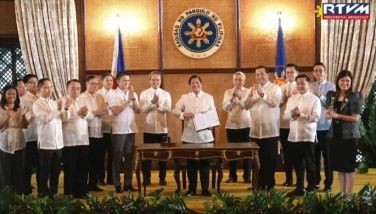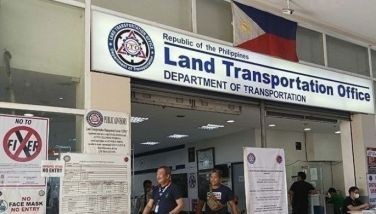The ‘sorry’ state of NAIA 1
The horrible conditions at the Ninoy Aquino International Airport (NAIA) 1 terminal are driving public outrage, and no amount of apology from the President, Transportation Secretary Jun Abaya or Manila International Airport Authority general manager Jose Angel Honrado can appease the fury of passengers.
This was how former Bb. Pilipinas International Yogi Dominguez-Zaragoza felt when she and many others were flying back to the United States last Thursday. Yogi described her experience at the NAIA 1 terminal as traumatic, saying she felt hot and uncomfortable the minute she stepped in because of the busted air conditioning. “I was dressed in layers in preparation for the expected cold temperature in the airplane. But even as I peeled off some layers, I still ended up soaked in my own sweat,†she narrated, adding that some electric fans placed in random locations were ineffective.
Like Ms. Dominguez, people are not buying the airport renovation as an excuse for the sweltering conditions inside the terminal. Part of the rehabilitation includes the purchase of new air conditioning units which were ordered from the supplier last November – but guess what, these new aircons will only be delivered in August! That’s nine months of purgatory that passengers have to put up with because somebody was not smart enough to anticipate the “heated†situation inside the terminal and put contingency measures into place.
Ms. Dominguez called the conditions “inhuman†not only for the tourists, but also the employees at NAIA. She’s challenging the big bosses of DOTC, MIAA and related agencies to step out of their comfy offices and try working at the NAIA terminal for eight hours just so they have a taste of what it’s like for passengers and employees who have to endure the sweltering situation.
Another passenger who also experienced the horribly inhuman conditions at NAIA agrees that officials should be made to suffer the same way the public and their poor employees are suffering, by requiring them to work in the frontlines instead of their air conditioned rooms. The same goes for those running the train system – they should be required to travel to work via the LRT or MRT just so they know the kind of inconvenience and aggravation the riding public goes through day in and day out.
The President is “sorry†and is asking everyone to be patient until the aircons are delivered this August – but as many observed, it will be too late because summer will soon be over. Perhaps it’s time for the President to make heads roll and stop apologizing for them.
GMA 7: Still for sale?
It looks like San Miguel’s Ramon Ang is still buying a minority stake in the GMA 7 “Kapuso†Network, prompting PLDT chief Manny V. Pangilinan to decide not to go into a bidding war. PLDT’s purchase offer via MediaQuest Holdings expired last Feb. 8 and MVP said they are not renewing the offer to buy a majority stake in the network. Instead, we are told MVP will just concentrate on their other media assets such as TV5, Cignal TV and newspapers including The Philippine STAR and Business World.
GMA incidentally reported a huge dip in its earnings for the first quarter by as much as 46 percent to P325 million compared to P601 million for the same period last year. Recurring revenues for GMA fell four percent to P2.85 billon for the first quarter of 2014, a drop of 12 percent compared to the same period a year ago. Meantime, PLDT reported a net income of P9.4 billion for the first quarter of 2014, up two percent from the same period in 2013. PLDT’s consolidated revenues in the first quarter rose three percent to P41.2 billion driven by growth in its data and Internet services.
Water recycling a better option
A lot of readers reacted to our May 6 column item titled “Desalination: The answer to El Niño,†among them University of Sto. Tomas faculty member Neil Ian Lumanlan who agrees that telling people to save water is ineffective in solving a water crisis. Food production consumes 70 percent of freshwater resources, domestic use accounts for 10 percent with the remaining 20 percent utilized by industries. Considering the high population growth, demand for water has really risen over the years.
One of the hardest hit during an El Niño phenomenon is agriculture, with the intense heat already drying up crops in some provinces. But while desalination is an option, these are more suitable for freshwater production, Lumanlan said, quoting author G. Tyler Miller who said desalination is practical only for water-challenged, wealthy countries that can afford the cost of the technology. He is advocating water recycling as a more viable option. Israel, acknowledged as the global leader when it comes to desalination technology, actually uses water recycling for agriculture. About 75 percent of Israel’s sewage is treated and recycled with 50 percent used for crop irrigation.
Lumanlan’s experience as a Typhoon Ondoy survivor in 2009 has turned him into a passionate advocate for sustainability. Rehabilitation of damaged ecosystems such as rainforests and wetlands can naturally provide more water, while investments in wastewater treatment and recycling coupled with renewable power from solar and wind sources can provide freshwater in a sustainable manner without the problems associated with desalination (mainly higher salt concentrations poured back into the sea). As he correctly points out, we can no longer turn a blind eye to the effects of climate change – the most serious of which include damage to our environment and ecosystems, loss of jobs, malnutrition and hunger.
* * *
Email: [email protected].
- Latest
- Trending

































